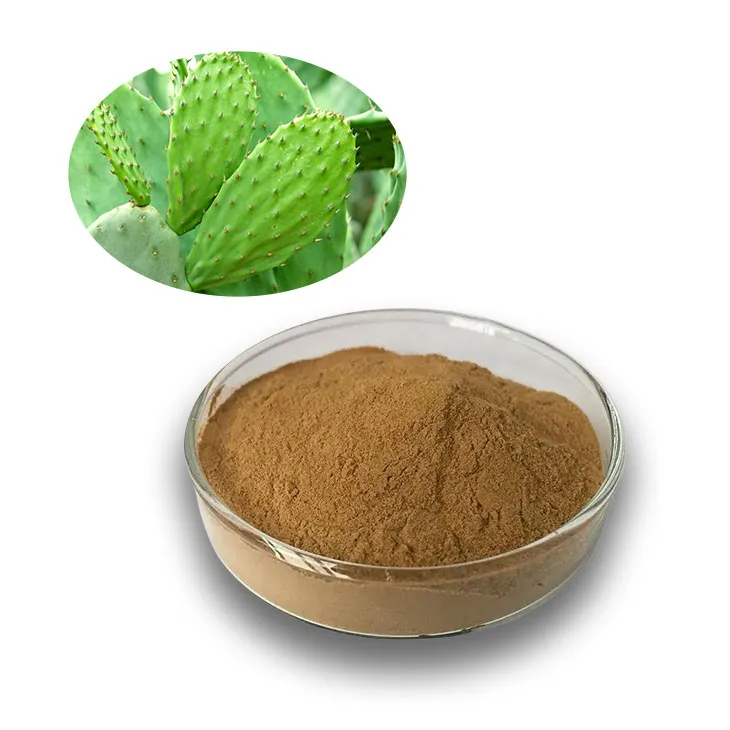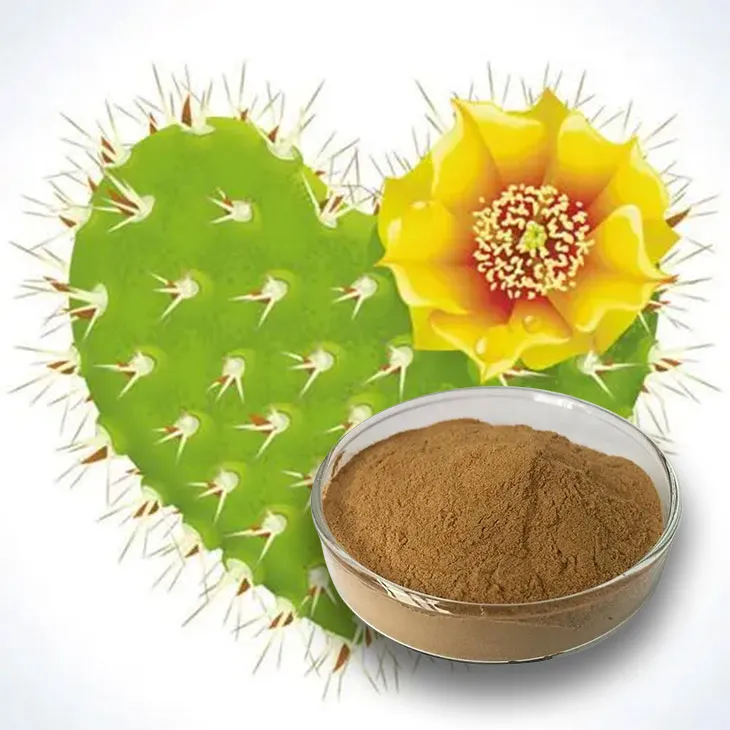- 0086-571-85302990
- sales@greenskybio.com
The extraction process of cactus extract.
2024-11-29

1. Introduction
Cactus plants are known for their unique properties and potential applications in various industries. The extraction of Cactus Extract is a process that aims to isolate and obtain the valuable compounds present in the cactus for use in different products such as food supplements, skincare, and pharmaceuticals. This process is complex and involves multiple steps, each of which plays a crucial role in obtaining a high - quality Cactus Extract.

2. Cactus Selection
Proper cactus species identification is the first and crucial step in the extraction process. Different cactus species contain different types of compounds, and the choice of species depends on the desired properties of the extract. For example, some cactus species may be rich in antioxidants, while others may contain compounds with anti - inflammatory properties.
Additionally, the quality and origin of the cactus also matter. Cacti grown in different regions may have variations in their chemical composition due to differences in soil, climate, and other environmental factors. Therefore, it is important to source cacti from reliable and suitable locations.

3. Pretreatment of Cactus
Once the cactus is sourced, it needs to be pretreated before extraction. Pretreatment helps to prepare the cactus for more efficient extraction of its valuable compounds.
3.1 Cleaning
The cactus should be thoroughly cleaned to remove any dirt, debris, or other contaminants. This can be done by gently washing the cactus with clean water. It is important to be careful during the cleaning process to avoid damaging the cactus.
3.2 Cutting
After cleaning, the cactus is often cut into appropriate sizes. Cutting the cactus into smaller pieces can increase the surface area available for extraction, which in turn improves the extraction efficiency. The size of the cut pieces may vary depending on the extraction method used. For example, for solvent extraction, smaller pieces may be more suitable as they can be more easily submerged in the solvent and allow for better contact between the cactus tissue and the solvent.

4. Extraction Methods
There are several methods available for extracting Cactus Extract, each with its own advantages and limitations.
4.1 Solvent Extraction
Solvent extraction is one of the most commonly used methods. In this method, a suitable solvent is used to dissolve the valuable compounds from the cactus. The choice of solvent is critical as it should be able to selectively dissolve the target compounds while leaving behind unwanted substances.
Common solvents used in cactus extraction include ethanol, methanol, and water. Ethanol is often preferred as it is relatively safe, has a good solubility for many cactus compounds, and is also suitable for use in products that may come into contact with human skin or be consumed, such as in food supplements and skincare products.
The process of solvent extraction typically involves soaking the pretreated cactus pieces in the solvent for a certain period of time. This allows the solvent to penetrate the cactus tissue and dissolve the compounds of interest. The mixture is then usually stirred or agitated to enhance the extraction process. After extraction, the solvent - containing extract is separated from the remaining cactus solids, usually by filtration.
4.2 Supercritical Fluid Extraction
Supercritical fluid extraction is an advanced and more environmentally friendly alternative to solvent extraction. In this method, a supercritical fluid, most commonly supercritical carbon dioxide (CO2), is used as the extracting agent.
Supercritical CO2 has unique properties that make it an excellent choice for extraction. It has a low viscosity and high diffusivity, which allows it to penetrate the cactus tissue easily and quickly extract the valuable compounds. Moreover, supercritical CO2 is non - toxic, non - flammable, and leaves no residue, which is highly desirable for applications in the food and skincare industries.
The supercritical fluid extraction process involves pressurizing and heating carbon dioxide to its supercritical state. The pretreated cactus is then exposed to the supercritical CO2 in an extraction vessel. The valuable compounds are dissolved in the supercritical CO2, and the extract - laden CO2 is then depressurized and cooled to separate the extract from the CO2, which can be recycled for further use.
5. Separation and Purification
After extraction, the resulting extract may contain not only the desired compounds but also other substances such as solvents, impurities, and cellular debris. Therefore, separation and purification steps are necessary to obtain a pure cactus extract.
5.1 Centrifugation
Centrifugation is often used as an initial separation step. Centrifugation works by subjecting the extract - containing mixture to a high - speed rotation. This causes the denser particles, such as cellular debris, to sediment at the bottom of the centrifuge tube, while the supernatant, which contains the dissolved cactus extract, can be easily separated.
5.2 Filtration
Filtration is another important method for separating the extract from solid impurities. There are different types of filtration methods available, such as gravity filtration, vacuum filtration, and membrane filtration. Depending on the nature of the impurities and the requirements of the final product, an appropriate filtration method can be chosen.
For example, membrane filtration can be used to remove very fine particles and even some dissolved impurities, depending on the pore size of the membrane. This can help to further purify the cactus extract and improve its quality.
6. Drying
After separation and purification, the cactus extract usually contains a significant amount of water or solvent, depending on the extraction method used. Drying is the final step in the extraction process to obtain a dry and stable cactus extract product.
6.1 Freeze - drying
Freeze - drying, also known as lyophilization, is a preferred drying method for cactus extract in many cases. In freeze - drying, the cactus extract is first frozen, and then the water or solvent is removed by sublimation under reduced pressure.
This method has several advantages. It helps to preserve the bioactive compounds in the cactus extract as the drying process occurs at low temperatures, minimizing the degradation of heat - sensitive compounds. Additionally, freeze - drying results in a porous and easily rehydratable product, which is beneficial for applications where the extract may need to be reconstituted, such as in some food and beverage products.
6.2 Spray Drying
Spray drying is another option for drying cactus extract. In this method, the cactus extract is atomized into a fine spray and then dried by hot air. Spray drying is a relatively fast and cost - effective method, especially for large - scale production.
However, the high temperatures involved in spray drying may cause some degradation of heat - sensitive compounds in the cactus extract. Therefore, it may not be suitable for extracts that contain highly sensitive bioactive substances.
7. Conclusion
The extraction process of cactus extract involves multiple steps, from cactus selection and pretreatment to extraction, separation, purification, and drying. Each step is crucial in obtaining a high - quality cactus extract that can be used in various industries such as food supplements, skincare, and pharmaceuticals. With the increasing demand for natural and sustainable products, the extraction of cactus extract is likely to gain more attention in the future, and further research may be carried out to optimize the extraction process and explore new applications of cactus extract.
FAQ:
What are the important factors in choosing cactus species for extraction?
The choice of cactus species depends on the desired properties of the extract. Different cactus species may contain different types of valuable compounds. For example, some species might be rich in antioxidants, while others could have specific nutrients or bioactive substances that are targeted for extraction for use in particular industries such as food supplements or skincare.
How does solvent extraction work in cactus extract production?
Solvent extraction involves using a suitable solvent to dissolve the desired compounds from the cactus. The cactus material is soaked in the solvent, and over time, the compounds of interest transfer from the solid cactus into the solvent. The solvent is then separated from the remaining solid cactus material, and the dissolved compounds can be further processed. However, it is important to choose a solvent that is safe, effective, and does not leave harmful residues in the final extract.
What are the advantages of supercritical fluid extraction over solvent extraction in cactus extract?
Supercritical fluid extraction, especially with supercritical CO2, has several advantages. It is a more environmentally friendly method as CO2 is non - toxic and can be easily removed without leaving harmful residues. It also offers better selectivity, which means it can target specific compounds more precisely compared to some solvent extraction methods. Additionally, it can often operate at lower temperatures, which helps to preserve the integrity of heat - sensitive compounds in the cactus.
Why is centrifugation used after extraction of cactus extract?
Centrifugation is used to separate the extract from other substances. After extraction, the resulting mixture may contain the extract along with solid particles, unextracted plant matter, or other impurities. Centrifugation uses the principle of centrifugal force to separate substances of different densities. This helps to purify the extract by removing these unwanted components, resulting in a cleaner and more concentrated cactus extract.
What are the benefits of freeze - drying in the production of cactus extract?
Freeze - drying has several benefits in the production of cactus extract. It helps to preserve the quality of the extract by minimizing the degradation of bioactive compounds. Since freeze - drying removes water in a way that does not expose the extract to high temperatures for long periods, it can retain the potency of the extract. Additionally, freeze - dried extracts are often more stable during storage and can be easily reconstituted when needed for further processing or use in various products.
Related literature
- Extraction and Characterization of Bioactive Compounds from Cactus: A Review"
- "Advanced Extraction Techniques for Cactus - Derived Nutraceuticals"
- "Optimization of Cactus Extract Production for Skincare Applications"
- ▶ Hesperidin
- ▶ citrus bioflavonoids
- ▶ plant extract
- ▶ lycopene
- ▶ Diosmin
- ▶ Grape seed extract
- ▶ Sea buckthorn Juice Powder
- ▶ Beetroot powder
- ▶ Hops Extract
- ▶ Artichoke Extract
- ▶ Reishi mushroom extract
- ▶ Astaxanthin
- ▶ Green Tea Extract
- ▶ Curcumin Extract
- ▶ Horse Chestnut Extract
- ▶ Other Problems
- ▶ Boswellia Serrata Extract
- ▶ Resveratrol Extract
- ▶ Marigold Extract
- ▶ Grape Leaf Extract
- ▶ blog3
- ▶ blog4
-
Nature's best vitamin D3.
2024-11-29
-
The best velvet antlers in 2024.
2024-11-29
-
Citrus Aurantium Extract
2024-11-29
-
White Willow Bark Extract
2024-11-29
-
Diosmin
2024-11-29
-
Fenugreek Extract Powder
2024-11-29
-
Camu Camu Extract
2024-11-29
-
Eyebright Extract
2024-11-29
-
Red Vine Extract
2024-11-29
-
Longan Extract
2024-11-29
-
Mangosteen extract powder
2024-11-29
-
Troxerutin
2024-11-29





















